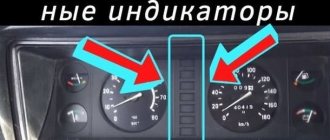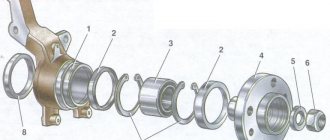Purpose of bracelets
The design of anti-skid bracelets is a combination of several parts: a chain, a strap and a self-tightening lock. Unlike chains, bracelets do not need to be installed in advance; they can be attached immediately before icy conditions or before driving on a slippery road.
Such devices allow you to safely drive on snowy roads, avoid slipping, and also provide additional safety due to tighter adhesion to the road surface. Car owners often purchase bracelets before traveling to mountainous areas, before heavy snowfalls or frosts. A huge advantage is that anyone can install a bracelet on a tire: this does not require any special skills or knowledge.
Characteristics of anti-skid bracelets
Despite the general scheme of how snow bracelets work, there are several different options. Basically, all models differ in size and number of chains.
The size directly depends on the type of car:
- for passenger cars, bracelets with one row of chains are suitable;
- for medium-sized minibuses and SUVs, thicker options with two rows of chains will be needed;
- for trucks and buses - professional large bracelets with thick chains in two or three rows.
In their action, bracelets are almost similar to standard chains. In this case, how do you understand when chains are needed and when you can get by with a lighter option?
If you are planning a long trip, during which you will be driving on dangerous snowy roads all the time, then it is better to immediately install special chains. If along the route it is expected that only a small part of it will be snow-covered, then bracelets are a better option.
Advantages of bracelets
If we consider the advantages of bracelets, then first of all it should be noted that it is very difficult to make chains for wheels with your own hands, in contrast to the simpler option.
Anti-slip bracelets are much cheaper due to the small number of parts and ease of manufacture. In addition, for many drivers, a big advantage is that such bracelets are much less harmful to tires, unlike chains.
Homemade anti-slip bracelets are easy to attach on the go; it only takes a few spare minutes. It's also easy to remove them later.
Disadvantages of bracelets
Despite the large number of advantages, there are also several disadvantages:
- if the bracelet is not fastened correctly, it may come unfastened while traveling;
- not always suitable for mountain roads.
Obviously, the advantages of anti-slip bracelets are much greater than the disadvantages. However, much also depends on the quality of the product and how correctly it was attached to the wheels.
For those who want to make bracelets themselves
In order to make anti-slip bracelets with your own hands, you need to stock up on some materials. For one bracelet you will need:
- Two pieces of chain, five centimeters long, are greater than the width of the wheel tread.
The chain should be such that an M8 screw fits into the outermost link of the segment. The joints of its links must be welded or soldered with copper, otherwise they may be torn during operation. The larger the chain links, the better lugs it will make. But before choosing a chain, measure the narrowest point between the tire and the wheel arch. The chain placed on the tire tread should pass this place without reaching the arch with a good margin. Since if it is missing, if dirt gets under it, it will start to touch the body. Self-locking nut - Two M8× bolts
- Two steel tubes with an internal diameter of 8.5 mm, about 4 cm long. Or eight regular M8 nuts. Take what is easier for you to find.
- Two M8 self-locking nuts.
- Four wide washers with a hole diameter of 8 mm.
- One lanyard or belt with a metal buckle.
- One sling or belt without a buckle.
- Thick nylon threads.
Cargo tie-down straps
The tools you will need are: two open-end wrenches the size of the nuts and bolt heads, an awl and a needle. To find out the tread width, it is not necessary to measure it. This size is indicated on the sidewall of the tire. This designation looks like this: XXX/70 R 14 The first three numbers are the tread width in millimeters.
The chain can be purchased at a professional fastener store or in a regular hardware department. Look for a lanyard with buckles at a climbing equipment store. Once the materials and tools are collected, production can begin.
Take one of the bolts, put a washer on it, and after it the outermost link of one piece of chain. Now put on another washer and tube. If there is no tube, screw in 4 regular nuts and pull the structure through. Put on another washer and the outer link of another piece of chain. Cover the link with a washer, screw on the self-locking nut and tighten it. Similarly, fasten the other two edges of these sections of chain together. After the edges of the segments are connected. Loop the free end of a belt or sling with a buckle around one of the bolts, pull it towards the buckle and stitch it frequently with nylon thread using an awl and a needle. The length of the end with the buckle should be about 10 cm. In the same way, attach a belt or sling without a buckle to the other bolt. For ease of fastening, leave the length of this end longer; if necessary, you can shorten it later.
Useful little things
- To make it easier to pull a belt through the holes in the disc without a buckle, make a hook from steel wire with a diameter of about 3 mm, its length should be about 30 cm.
- An old top would be a good handbag for one bracelet.
- Tire bracelets should only be worn on drive wheels. Putting them on wheels without a drive increases their rolling resistance and worsens cross-country ability. The more bracelets are put on the drive wheels, the less the load on each chain, which means there is less chance of slipping and digging holes. But this does not mean that you need to put on as many of them as will fit on the wheel; look for the optimal number. Their number is directly dependent on the diameter of the wheels.
- If you're stuck in the snow and don't already have snow bracelets. But there is a rather thick towing cable in the trunks, try using it to improve the maneuverability of your car. To do this, insert it from the outside into the hole in the wheel rim, pull it out from the other side, pull it through the tread, do this several times and, whatever you use, secure the ends of the cable. Just make sure it doesn't cling to anything.
- After overcoming a difficult section of the path, do not forget to remove any anti-skid bracelets, as they are not intended for long-term use.
Ready-made anti-slip bracelets
If you don’t want to make your own anti-slip bracelets, you can always purchase a ready-made version. The stores offer a huge assortment of a wide variety of options, differing in both quality and price. You should definitely choose, taking into account the characteristics of your car, as well as the factors of the area where you are going. Having visited the store, you can immediately understand that the finished products are divided into “soft” and “hard” options. Let's look at what their differences are.
How to choose bracelets for wheels for a passenger car?
As mentioned above, you can choose a bracelet for any type of vehicle, regardless of size. It is imperative that you need to do when purchasing - clarify what diameter the tires should be so that you can put on the device without any problems.
Based on size, bracelets are usually divided into three main types:
- The first option is suitable for tires with a maximum size of 225/70, but the radius should not exceed 17. These data are typical for cars that are not very heavy.
- The second version of the bracelets is with a maximum wheel size of 225/75 and a radius of up to 20. Designed for SUVs and small buses.
- The third and final type of bracelets is made for wheels with a size of up to 315/80 and a radius not exceeding 22.5. Designed exclusively for large vehicles (trucks, buses).
Size is not the last criterion that needs to be taken into account when choosing bracelets for wheels. The standard quantity per package is 6 pieces, which means installing three pieces on each drive wheel. However, if the car is all-wheel drive, it is worth purchasing an additional kit. You may never need it, but it’s better to protect yourself from unnecessary grief and trouble in the future.
Of course, when choosing this or that product, you should pay attention to quality. All links of the bracelet must be cast, and the structure must be solid, without the slightest breaks. According to standards, fastening straps are made of leather and sewn with several seams.
An interesting fact is that the pricing policy for traction control bracelets on wheels is completely different. This is due to the fact that the final price of the product is made up of many nuances:
- State in which the bracelets were made.
- Strength properties of materials.
- Number of pieces per package (their number may vary depending on the set).
- Dimensions of the final product.
Hard chains
Rigid chains are made from a special weave of metal and reinforced chains. This method allows you to safely drive through deep snowdrifts, icy roads, ascents and descents. Please note that after you have attached the hard bracelets to the wheels, it is recommended to drive at a speed of no more than 40 km per hour. This is precisely the biggest disadvantage of this option. However, if you have to travel off-road or along mountain serpentine roads, then this is the best way to protect yourself and your car.
It is highly not recommended to use rigid chains all the time: the rubber will begin to wear out much faster.
Making your own anti-slip bracelets
A distinctive feature of anti-slip bracelets is that, with a little experience, you can not only secure them yourself, but also make them yourself. Let's consider what materials are needed for this, as well as detailed instructions.
Materials for bracelets
Making snow chains with your own hands is not that difficult. To do this you need to purchase:
- rubber chain - one or two strips of 15 links (the number of strips depends on the chosen bracelet option);
- M5 bolts - 2 pieces;
- M5 nuts - 16 pcs;
- self-locking nuts M5 - 2 pcs;
- body washers - 8 pcs;
- self-tightening lock - 1 piece.
All these materials are designed to make one bracelet. For a light car, on average, you will need 12 finished products (3 bracelets per wheel). Please also note that depending on your vehicle, the number and size of components may vary.
You can find and buy the above parts both in a store for car enthusiasts and in construction departments.
Step-by-step instruction
You can make anti-slip bracelets with your own hands as follows:
- take the chain and secure the bolt to one end with a washer;
- screw 8 nuts onto the bolt;
- connect the second piece of chain using a self-locking nut;
- repeat the steps with opposite ends of the two pieces of chain;
- measure the required bracelet size;
- We insert a belt with a self-tightening lock onto either side of the bracelet;
- testing the resulting bracelet on wheels;
- If necessary, you can cut off the excess part of the belt.
After completing these steps several times, you will receive a complete set of ready-made anti-skid bracelets for affordable money. Depending on your own wishes, you can change the size of the bolts, the number of chains, the length of the belts, and so on.
Which is better, chains or snow bracelets?
Anti-slip bracelets consist of 2 parts of a chain, which are connected in pairs by two belts. One belt has a buckle and the other is loose. It is necessary to put anti-slip on the wheel so that the chain, which forms the lugs, is on the tire tread in 2 rows so that there is a slight gap between the rows of chains. The free end of the belt must be passed through the hole in the wheel rim, then the belt must be tightened and fastened.
A chain or bracelet alone is not enough to improve the vehicle's cross-country ability. The set usually includes 6 bracelets. One set for a vehicle with one drive axle (not all-wheel drive). For cars with all-wheel drive, it is advisable to install bracelets on all wheels. In this case, the cross-country ability will increase significantly.
To be effective, you need to put 3 bracelets on each drive wheel, with equal intervals between them. You can either buy it or make it yourself. Plus, if you do it yourself, you can improve some points.
This is what snow bracelets look like
This is what snow chains look like
The difference between bracelets and snow chains is that when installing bracelets, you do not need to jack up the car. This is very convenient, as you can even put it on the wheels when the car is already stuck.
Anyone who has 2-3 days of free time and some materials can make a manual tire changing machine with their own hands. To do this, you just need: a welding machine with electrodes, rectangular and round pipes, and a couple of 5 mm thick plates.
As for the effectiveness of using bracelets, they are not inferior to chains. By the way, you should not drive haphazardly through mud or loose snow, even with chains or snow bracelets, because if the car sits on the bottom (the bottom lies on the mud or snow, and the wheels hang), then such improvements in cross-country ability will not help.
The bracelets are safe to use. If the belt or chain of the bracelet breaks, the body usually does not hit.
In Russia, few people use means to improve cross-country ability in the form of mounted auto accessories (gizmos) than in Europe. There are roads in Europe where driving is prohibited without chains or snow bracelets in the trunk.
Do you know the rules for transporting oversized cargo? If these rules are not followed, the car will overturn.
Installation of bracelets on wheels, mounting options
Installing bracelets on wheels is not a particular problem. There are several mounting options you need to be aware of. The difference between them is quite significant:
- The first option is to install bracelets only on the rear wheels. This method is especially relevant for cars with front-wheel drive.
- The second option is to install only on the front wheels. Accordingly, it is most effective for cars with rear-wheel drive.
- The third method is to install on all 4 wheels. The most reliable and safe option, guaranteeing maximum grip on the road.
The main rule, regardless of the fastening method, is an even distribution of bracelets. That is, if you attach a total of 3 belts to a wheel, then this must be done at an equal distance from each other. Only this method will minimize rubber wear and achieve precise anti-skid performance.
Materials and features of bracelets
Devices can be made of different materials, but the most common ones are:
- devices made of durable alloy steel;
- reinforced rubber fibers;
- polyurethane;
- bracelets made of high-strength plastic.
The more severe the road conditions, the more rigid the design of the device should be and the stronger the material should be. So, for shallow snow on hard compacted soil or asphalt, softer lugs are used and speed limits may not apply to them.
The use of traction control devices also depends on the diameter of the vehicle's wheels. Depending on the nature of the coating, choose a lug pattern: for deep snow it is more advisable to use a ladder; honeycombs and diamonds with a smaller pattern are intended more for icy roads.
Operation of snow bracelets
The use of anti-skid bracelets requires certain skills, since otherwise they can cause accidents or breakdowns.
Security measures
According to owner reviews, snow bracelets should be used as follows. Fasten carefully, checking the strength of the mechanisms several times. After this, you should drive 100 - 200 meters on a safe road, and then get out of the car and re-check the fastenings.
Such safety measures are taken to eliminate the possibility of any bracelet becoming detached during travel or the belt breaking. It is also recommended that before particularly dangerous trips, replace old fasteners that have been in constant use for a year or more.
Use of anti-skid bracelets
Many motorists who have recently encountered the problem of snowfalls, heavy ice and drifts have a question at what stage of the journey they need to fasten the bracelets and whether they should be used constantly. To answer this question, it is necessary to consider two situations.
If the driver constantly drives in a city that is normally cleared of snow, but occasionally there is still a need for an additional anti-slip option, then the bracelets should be attached immediately before a dangerous section of the road arises. Especially in the city, this is easy to do; you can stop and fasten your bracelets.
If you are planning a long trip, then you need to take care in advance about where exactly to attach the bracelets, since not all routes have the opportunity to make a stop.
How to make bracelets for wheels with your own hands?
As you know, good quality and good prices, so we suggest you consider the option of creating bracelets for wheels with your own hands from scrap materials. The first thing that needs to be done is to determine the diameter of the car’s tires, and also check the availability of the necessary tools and working materials.
When searching and selecting materials, it is worth considering two important points in advance:
- A passenger car requires less chain than a truck.
- You need to make at least two versions of bracelets for each wheel.
To directly make wheel bracelets with your own hands, we will need the following available materials and tools:
- Bolts with nuts (recommended M5 50), their number is determined as needed;
- A leather belt, and ideally a parachute lanyard with some kind of clip (bracelet holder);
- Durable, stress-resistant threads;
- Chain (length depends on wheel size);
- Needle and awl;
- Spanners.
Let's start making anti-slip bracelets from scrap materials:
- Having previously divided the chain into 15-20 links, attach a bolt to the edge and screw about 10 nuts onto it.
- We connect the pieces using nuts and washers. We perform the same actions on the other side of the chain.
- We take a piece of belt and divide it into two parts - one goes to the clamp, and we determine the length of the second based on the diameter of the wheel.
- We push the section with the buckle through the bolts, and we do it in such a way that the result is a loop, which is stitched with threads in several seams.
- The remaining piece of the belt is attached to the second side.
At this point, the manufacture of the device is considered complete. Other wheel hooks are made using the same scheme.
As you can see, it is quite possible to make bracelets for wheels with your own hands, spending a minimal amount of money on it. Of course, we have not described the most budget-friendly option for creating an accessory for tires. But, this is the most convenient design, allowing you to quickly install and remove bracelets from car wheels.
Useful videos: rules and options for using bracelets on wheels for a passenger car, be sure to watch!
An even simpler option is to tie a piece of rope to a chain and use it that way. But this is completely impractical and will look terrible. Although for one-time use such bracelets are quite suitable. What can you say about this option? You can share your opinion in the comments.
New articles
- What is engine chipping? Pros and cons of chip tuning
- Rigid hitch for a passenger car: its types, advantages and how to make it











